Fundamentals of Project Management: AF Plc Consultancy Report Analysis
VerifiedAdded on 2023/01/09
|25
|5422
|25
Project
AI Summary
This project management report analyzes a consultancy report for Automation Future (AF) plc, focusing on project management fundamentals. The executive summary provides an overview of the project's concerns and the importance of the project manager's role. Part A covers project definition, risk management with a risk register, project planning including network diagrams and Gantt charts, budget development, and earned value analysis. It includes a discussion on the iron triangle parameters (cost, time, scope, and quality), their interrelations, and their significance in setting project objectives. The report also details the importance of risk management and mitigation strategies. The project utilizes earned value analysis to compare planned versus actual progress and determine a revised completion date. Part B includes a reflective essay, and the report concludes with recommendations for project success.

Fundamentals of Project
Management
Management
Paraphrase This Document
Need a fresh take? Get an instant paraphrase of this document with our AI Paraphraser
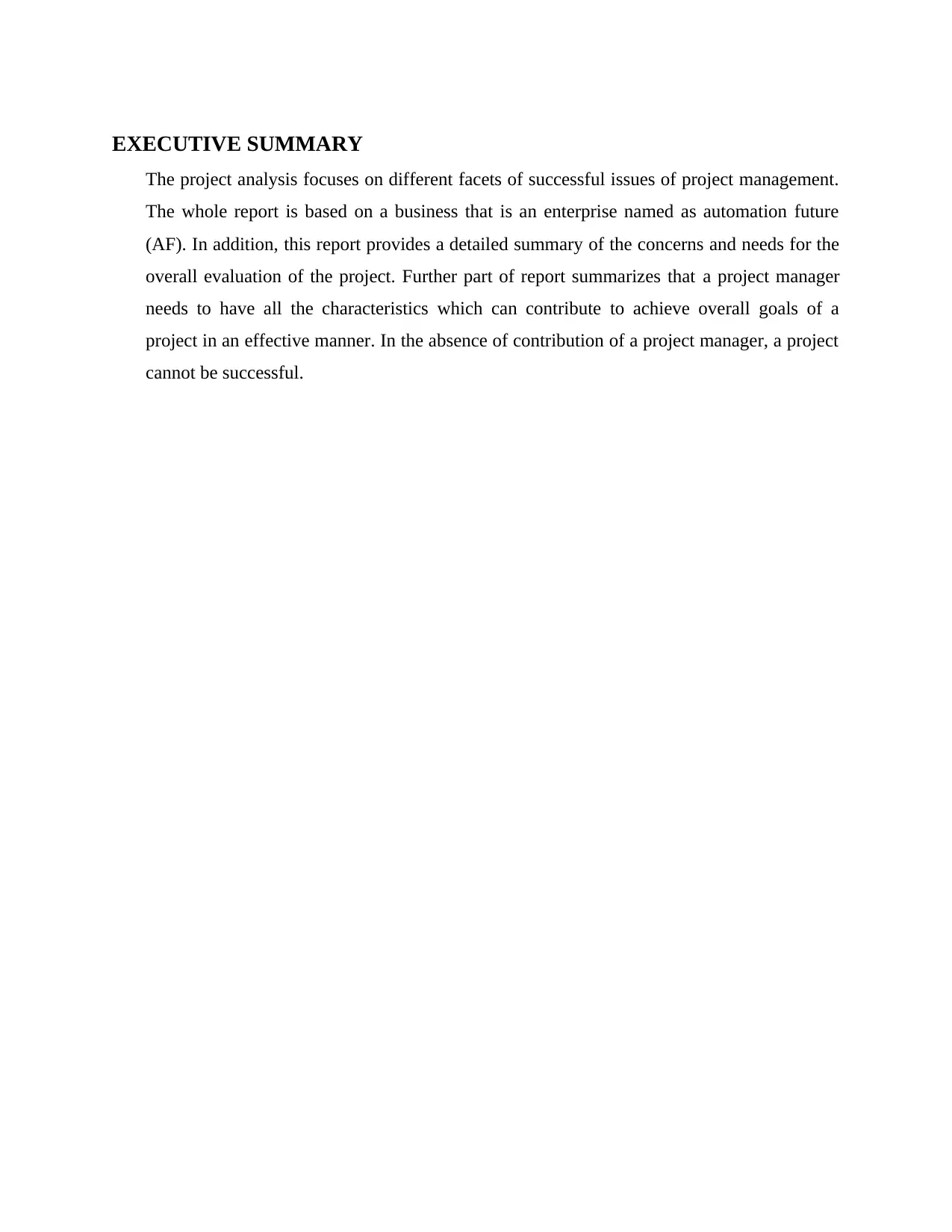
EXECUTIVE SUMMARY
The project analysis focuses on different facets of successful issues of project management.
The whole report is based on a business that is an enterprise named as automation future
(AF). In addition, this report provides a detailed summary of the concerns and needs for the
overall evaluation of the project. Further part of report summarizes that a project manager
needs to have all the characteristics which can contribute to achieve overall goals of a
project in an effective manner. In the absence of contribution of a project manager, a project
cannot be successful.
The project analysis focuses on different facets of successful issues of project management.
The whole report is based on a business that is an enterprise named as automation future
(AF). In addition, this report provides a detailed summary of the concerns and needs for the
overall evaluation of the project. Further part of report summarizes that a project manager
needs to have all the characteristics which can contribute to achieve overall goals of a
project in an effective manner. In the absence of contribution of a project manager, a project
cannot be successful.
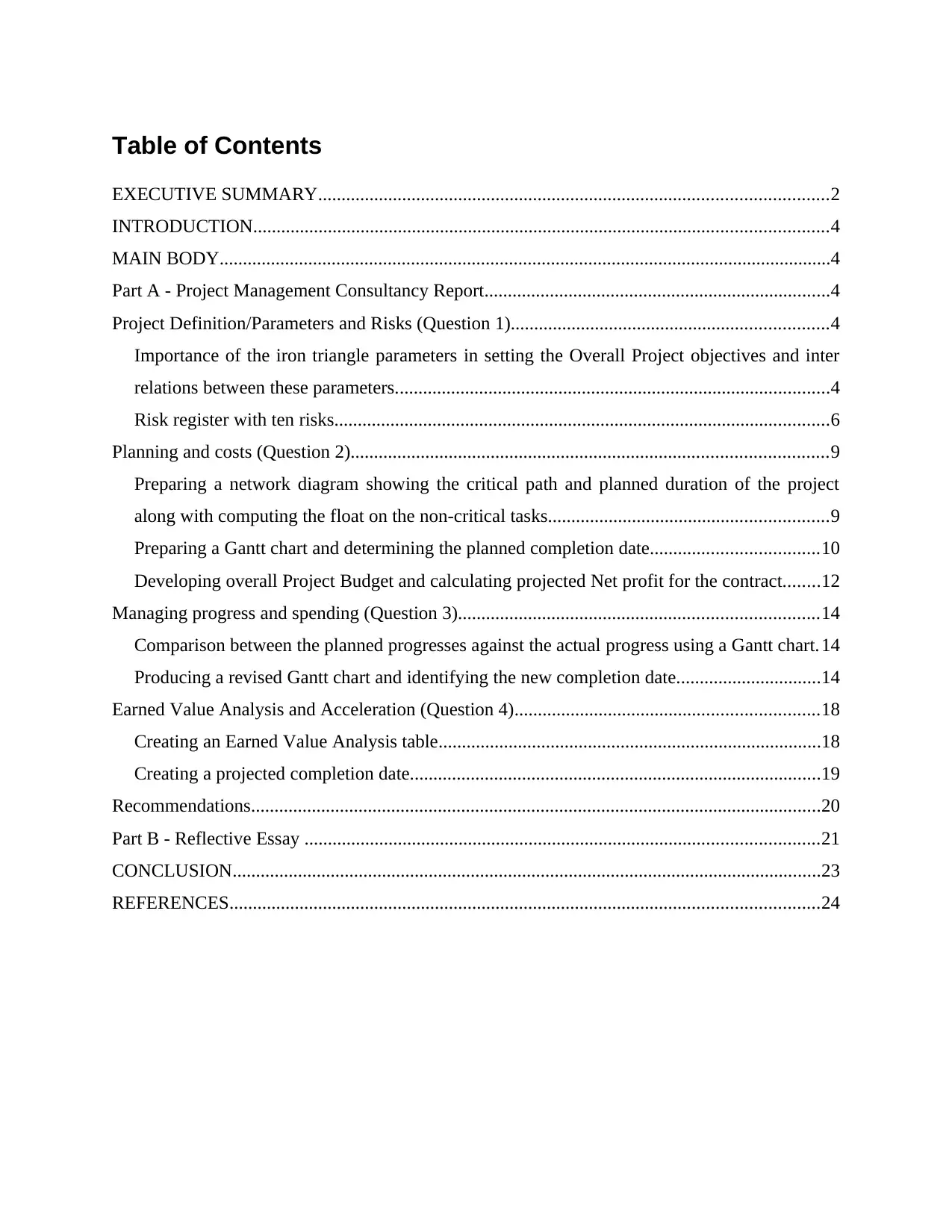
Table of Contents
EXECUTIVE SUMMARY.............................................................................................................2
INTRODUCTION...........................................................................................................................4
MAIN BODY...................................................................................................................................4
Part A - Project Management Consultancy Report..........................................................................4
Project Definition/Parameters and Risks (Question 1)....................................................................4
Importance of the iron triangle parameters in setting the Overall Project objectives and inter
relations between these parameters.............................................................................................4
Risk register with ten risks..........................................................................................................6
Planning and costs (Question 2)......................................................................................................9
Preparing a network diagram showing the critical path and planned duration of the project
along with computing the float on the non-critical tasks............................................................9
Preparing a Gantt chart and determining the planned completion date....................................10
Developing overall Project Budget and calculating projected Net profit for the contract........12
Managing progress and spending (Question 3).............................................................................14
Comparison between the planned progresses against the actual progress using a Gantt chart. 14
Producing a revised Gantt chart and identifying the new completion date...............................14
Earned Value Analysis and Acceleration (Question 4).................................................................18
Creating an Earned Value Analysis table..................................................................................18
Creating a projected completion date........................................................................................19
Recommendations..........................................................................................................................20
Part B - Reflective Essay ..............................................................................................................21
CONCLUSION..............................................................................................................................23
REFERENCES..............................................................................................................................24
EXECUTIVE SUMMARY.............................................................................................................2
INTRODUCTION...........................................................................................................................4
MAIN BODY...................................................................................................................................4
Part A - Project Management Consultancy Report..........................................................................4
Project Definition/Parameters and Risks (Question 1)....................................................................4
Importance of the iron triangle parameters in setting the Overall Project objectives and inter
relations between these parameters.............................................................................................4
Risk register with ten risks..........................................................................................................6
Planning and costs (Question 2)......................................................................................................9
Preparing a network diagram showing the critical path and planned duration of the project
along with computing the float on the non-critical tasks............................................................9
Preparing a Gantt chart and determining the planned completion date....................................10
Developing overall Project Budget and calculating projected Net profit for the contract........12
Managing progress and spending (Question 3).............................................................................14
Comparison between the planned progresses against the actual progress using a Gantt chart. 14
Producing a revised Gantt chart and identifying the new completion date...............................14
Earned Value Analysis and Acceleration (Question 4).................................................................18
Creating an Earned Value Analysis table..................................................................................18
Creating a projected completion date........................................................................................19
Recommendations..........................................................................................................................20
Part B - Reflective Essay ..............................................................................................................21
CONCLUSION..............................................................................................................................23
REFERENCES..............................................................................................................................24
⊘ This is a preview!⊘
Do you want full access?
Subscribe today to unlock all pages.

Trusted by 1+ million students worldwide
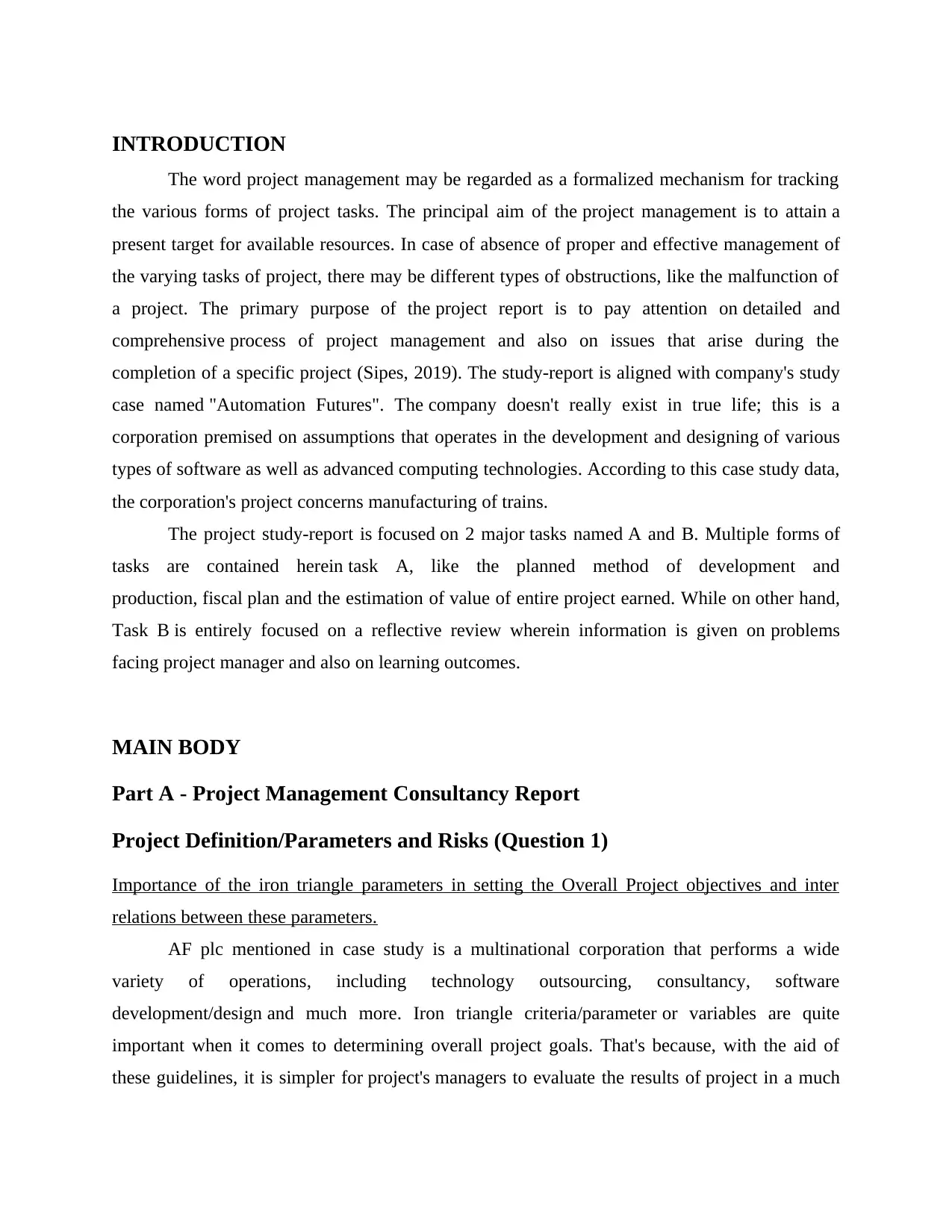
INTRODUCTION
The word project management may be regarded as a formalized mechanism for tracking
the various forms of project tasks. The principal aim of the project management is to attain a
present target for available resources. In case of absence of proper and effective management of
the varying tasks of project, there may be different types of obstructions, like the malfunction of
a project. The primary purpose of the project report is to pay attention on detailed and
comprehensive process of project management and also on issues that arise during the
completion of a specific project (Sipes, 2019). The study-report is aligned with company's study
case named "Automation Futures". The company doesn't really exist in true life; this is a
corporation premised on assumptions that operates in the development and designing of various
types of software as well as advanced computing technologies. According to this case study data,
the corporation's project concerns manufacturing of trains.
The project study-report is focused on 2 major tasks named A and B. Multiple forms of
tasks are contained herein task A, like the planned method of development and
production, fiscal plan and the estimation of value of entire project earned. While on other hand,
Task B is entirely focused on a reflective review wherein information is given on problems
facing project manager and also on learning outcomes.
MAIN BODY
Part A - Project Management Consultancy Report
Project Definition/Parameters and Risks (Question 1)
Importance of the iron triangle parameters in setting the Overall Project objectives and inter
relations between these parameters.
AF plc mentioned in case study is a multinational corporation that performs a wide
variety of operations, including technology outsourcing, consultancy, software
development/design and much more. Iron triangle criteria/parameter or variables are quite
important when it comes to determining overall project goals. That's because, with the aid of
these guidelines, it is simpler for project's managers to evaluate the results of project in a much
The word project management may be regarded as a formalized mechanism for tracking
the various forms of project tasks. The principal aim of the project management is to attain a
present target for available resources. In case of absence of proper and effective management of
the varying tasks of project, there may be different types of obstructions, like the malfunction of
a project. The primary purpose of the project report is to pay attention on detailed and
comprehensive process of project management and also on issues that arise during the
completion of a specific project (Sipes, 2019). The study-report is aligned with company's study
case named "Automation Futures". The company doesn't really exist in true life; this is a
corporation premised on assumptions that operates in the development and designing of various
types of software as well as advanced computing technologies. According to this case study data,
the corporation's project concerns manufacturing of trains.
The project study-report is focused on 2 major tasks named A and B. Multiple forms of
tasks are contained herein task A, like the planned method of development and
production, fiscal plan and the estimation of value of entire project earned. While on other hand,
Task B is entirely focused on a reflective review wherein information is given on problems
facing project manager and also on learning outcomes.
MAIN BODY
Part A - Project Management Consultancy Report
Project Definition/Parameters and Risks (Question 1)
Importance of the iron triangle parameters in setting the Overall Project objectives and inter
relations between these parameters.
AF plc mentioned in case study is a multinational corporation that performs a wide
variety of operations, including technology outsourcing, consultancy, software
development/design and much more. Iron triangle criteria/parameter or variables are quite
important when it comes to determining overall project goals. That's because, with the aid of
these guidelines, it is simpler for project's managers to evaluate the results of project in a much
Paraphrase This Document
Need a fresh take? Get an instant paraphrase of this document with our AI Paraphraser
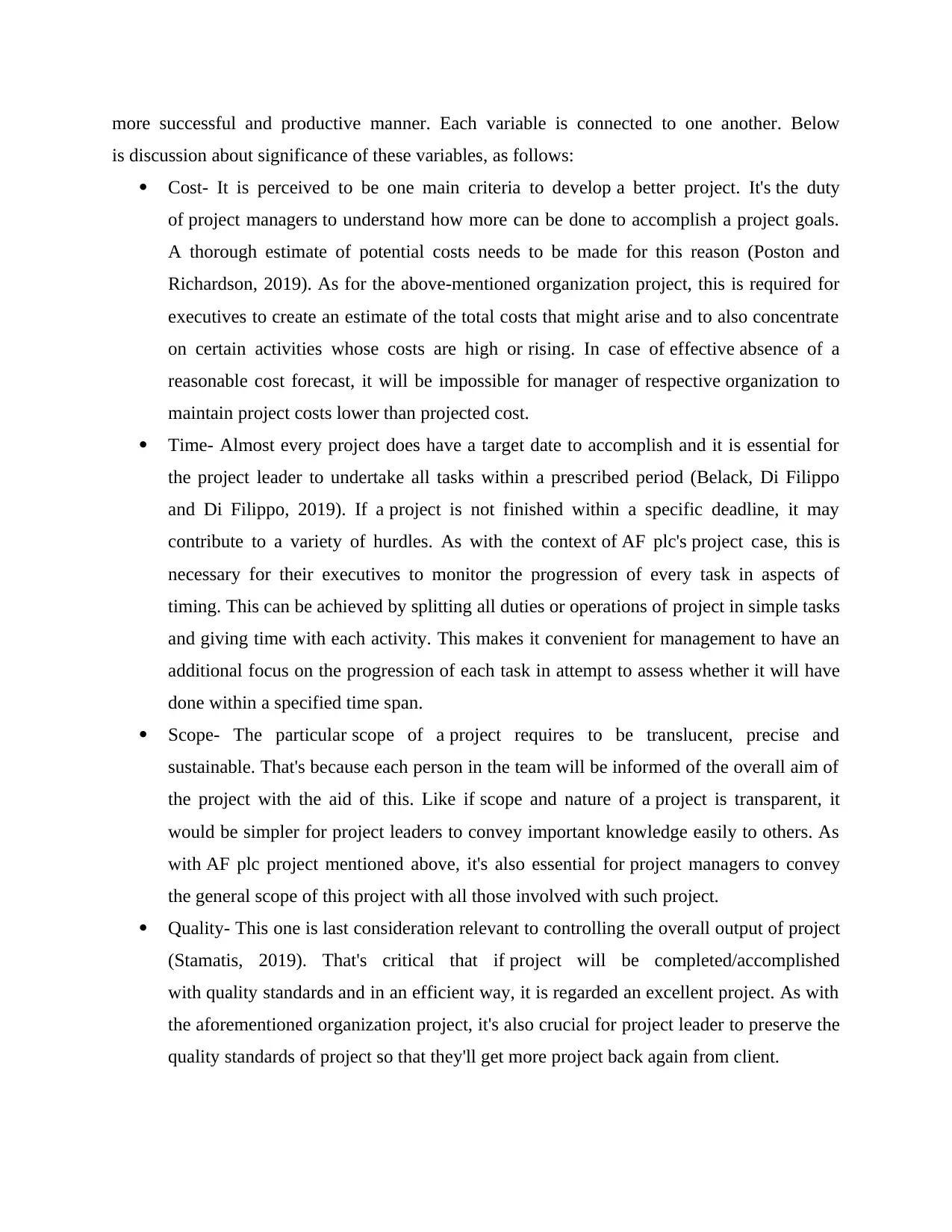
more successful and productive manner. Each variable is connected to one another. Below
is discussion about significance of these variables, as follows:
Cost- It is perceived to be one main criteria to develop a better project. It's the duty
of project managers to understand how more can be done to accomplish a project goals.
A thorough estimate of potential costs needs to be made for this reason (Poston and
Richardson, 2019). As for the above-mentioned organization project, this is required for
executives to create an estimate of the total costs that might arise and to also concentrate
on certain activities whose costs are high or rising. In case of effective absence of a
reasonable cost forecast, it will be impossible for manager of respective organization to
maintain project costs lower than projected cost.
Time- Almost every project does have a target date to accomplish and it is essential for
the project leader to undertake all tasks within a prescribed period (Belack, Di Filippo
and Di Filippo, 2019). If a project is not finished within a specific deadline, it may
contribute to a variety of hurdles. As with the context of AF plc's project case, this is
necessary for their executives to monitor the progression of every task in aspects of
timing. This can be achieved by splitting all duties or operations of project in simple tasks
and giving time with each activity. This makes it convenient for management to have an
additional focus on the progression of each task in attempt to assess whether it will have
done within a specified time span.
Scope- The particular scope of a project requires to be translucent, precise and
sustainable. That's because each person in the team will be informed of the overall aim of
the project with the aid of this. Like if scope and nature of a project is transparent, it
would be simpler for project leaders to convey important knowledge easily to others. As
with AF plc project mentioned above, it's also essential for project managers to convey
the general scope of this project with all those involved with such project.
Quality- This one is last consideration relevant to controlling the overall output of project
(Stamatis, 2019). That's critical that if project will be completed/accomplished
with quality standards and in an efficient way, it is regarded an excellent project. As with
the aforementioned organization project, it's also crucial for project leader to preserve the
quality standards of project so that they'll get more project back again from client.
is discussion about significance of these variables, as follows:
Cost- It is perceived to be one main criteria to develop a better project. It's the duty
of project managers to understand how more can be done to accomplish a project goals.
A thorough estimate of potential costs needs to be made for this reason (Poston and
Richardson, 2019). As for the above-mentioned organization project, this is required for
executives to create an estimate of the total costs that might arise and to also concentrate
on certain activities whose costs are high or rising. In case of effective absence of a
reasonable cost forecast, it will be impossible for manager of respective organization to
maintain project costs lower than projected cost.
Time- Almost every project does have a target date to accomplish and it is essential for
the project leader to undertake all tasks within a prescribed period (Belack, Di Filippo
and Di Filippo, 2019). If a project is not finished within a specific deadline, it may
contribute to a variety of hurdles. As with the context of AF plc's project case, this is
necessary for their executives to monitor the progression of every task in aspects of
timing. This can be achieved by splitting all duties or operations of project in simple tasks
and giving time with each activity. This makes it convenient for management to have an
additional focus on the progression of each task in attempt to assess whether it will have
done within a specified time span.
Scope- The particular scope of a project requires to be translucent, precise and
sustainable. That's because each person in the team will be informed of the overall aim of
the project with the aid of this. Like if scope and nature of a project is transparent, it
would be simpler for project leaders to convey important knowledge easily to others. As
with AF plc project mentioned above, it's also essential for project managers to convey
the general scope of this project with all those involved with such project.
Quality- This one is last consideration relevant to controlling the overall output of project
(Stamatis, 2019). That's critical that if project will be completed/accomplished
with quality standards and in an efficient way, it is regarded an excellent project. As with
the aforementioned organization project, it's also crucial for project leader to preserve the
quality standards of project so that they'll get more project back again from client.
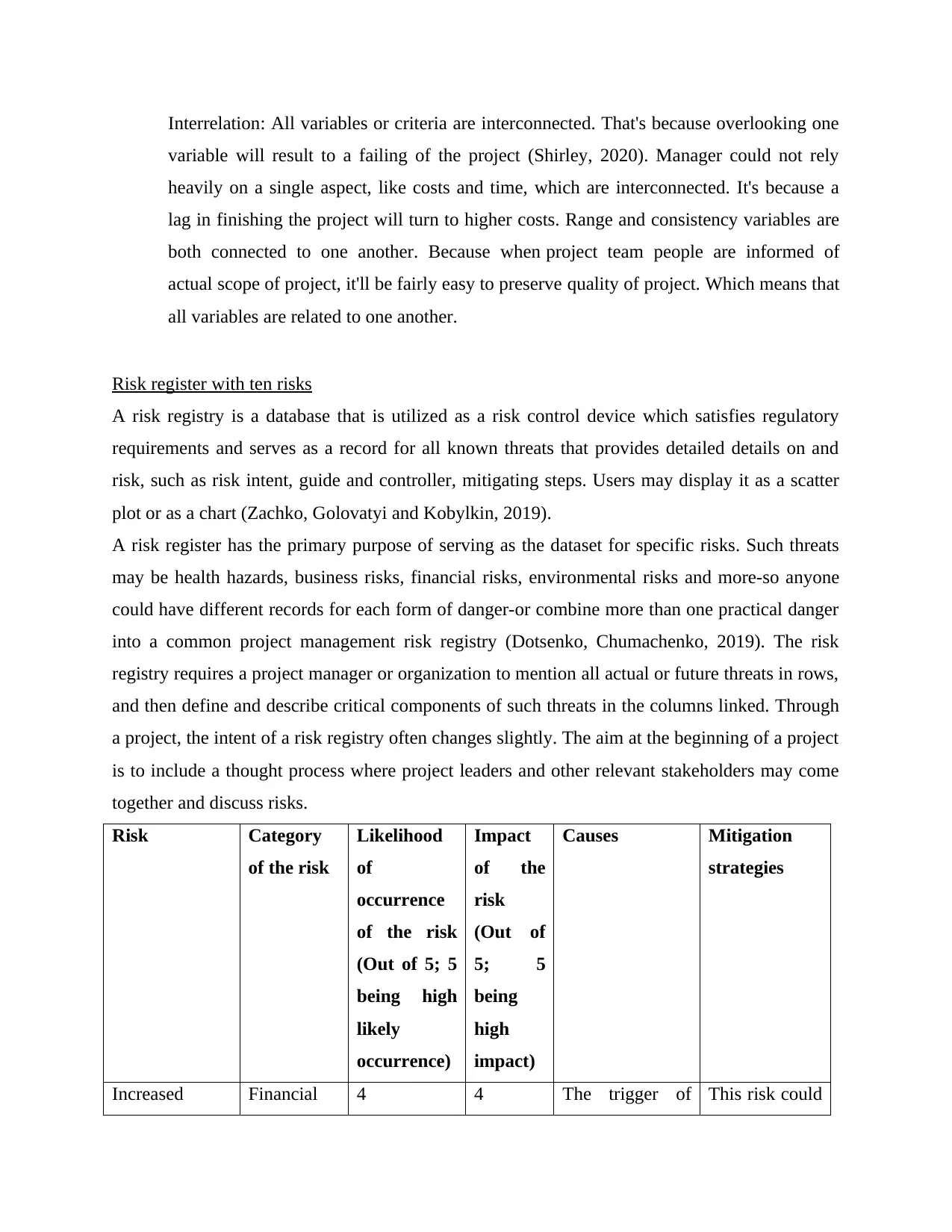
Interrelation: All variables or criteria are interconnected. That's because overlooking one
variable will result to a failing of the project (Shirley, 2020). Manager could not rely
heavily on a single aspect, like costs and time, which are interconnected. It's because a
lag in finishing the project will turn to higher costs. Range and consistency variables are
both connected to one another. Because when project team people are informed of
actual scope of project, it'll be fairly easy to preserve quality of project. Which means that
all variables are related to one another.
Risk register with ten risks
A risk registry is a database that is utilized as a risk control device which satisfies regulatory
requirements and serves as a record for all known threats that provides detailed details on and
risk, such as risk intent, guide and controller, mitigating steps. Users may display it as a scatter
plot or as a chart (Zachko, Golovatyi and Kobylkin, 2019).
A risk register has the primary purpose of serving as the dataset for specific risks. Such threats
may be health hazards, business risks, financial risks, environmental risks and more-so anyone
could have different records for each form of danger-or combine more than one practical danger
into a common project management risk registry (Dotsenko, Chumachenko, 2019). The risk
registry requires a project manager or organization to mention all actual or future threats in rows,
and then define and describe critical components of such threats in the columns linked. Through
a project, the intent of a risk registry often changes slightly. The aim at the beginning of a project
is to include a thought process where project leaders and other relevant stakeholders may come
together and discuss risks.
Risk Category
of the risk
Likelihood
of
occurrence
of the risk
(Out of 5; 5
being high
likely
occurrence)
Impact
of the
risk
(Out of
5; 5
being
high
impact)
Causes Mitigation
strategies
Increased Financial 4 4 The trigger of This risk could
variable will result to a failing of the project (Shirley, 2020). Manager could not rely
heavily on a single aspect, like costs and time, which are interconnected. It's because a
lag in finishing the project will turn to higher costs. Range and consistency variables are
both connected to one another. Because when project team people are informed of
actual scope of project, it'll be fairly easy to preserve quality of project. Which means that
all variables are related to one another.
Risk register with ten risks
A risk registry is a database that is utilized as a risk control device which satisfies regulatory
requirements and serves as a record for all known threats that provides detailed details on and
risk, such as risk intent, guide and controller, mitigating steps. Users may display it as a scatter
plot or as a chart (Zachko, Golovatyi and Kobylkin, 2019).
A risk register has the primary purpose of serving as the dataset for specific risks. Such threats
may be health hazards, business risks, financial risks, environmental risks and more-so anyone
could have different records for each form of danger-or combine more than one practical danger
into a common project management risk registry (Dotsenko, Chumachenko, 2019). The risk
registry requires a project manager or organization to mention all actual or future threats in rows,
and then define and describe critical components of such threats in the columns linked. Through
a project, the intent of a risk registry often changes slightly. The aim at the beginning of a project
is to include a thought process where project leaders and other relevant stakeholders may come
together and discuss risks.
Risk Category
of the risk
Likelihood
of
occurrence
of the risk
(Out of 5; 5
being high
likely
occurrence)
Impact
of the
risk
(Out of
5; 5
being
high
impact)
Causes Mitigation
strategies
Increased Financial 4 4 The trigger of This risk could
⊘ This is a preview!⊘
Do you want full access?
Subscribe today to unlock all pages.

Trusted by 1+ million students worldwide
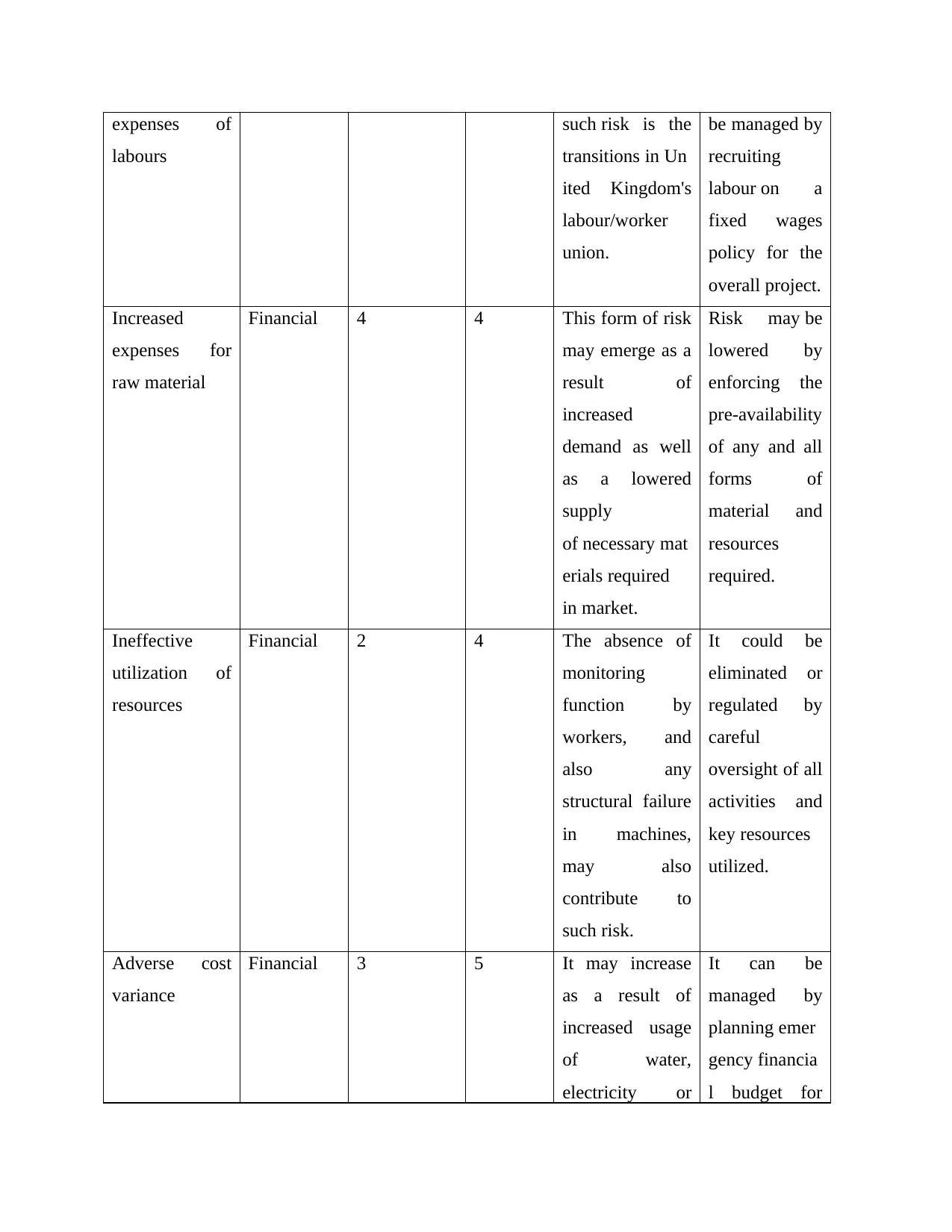
expenses of
labours
such risk is the
transitions in Un
ited Kingdom's
labour/worker
union.
be managed by
recruiting
labour on a
fixed wages
policy for the
overall project.
Increased
expenses for
raw material
Financial 4 4 This form of risk
may emerge as a
result of
increased
demand as well
as a lowered
supply
of necessary mat
erials required
in market.
Risk may be
lowered by
enforcing the
pre-availability
of any and all
forms of
material and
resources
required.
Ineffective
utilization of
resources
Financial 2 4 The absence of
monitoring
function by
workers, and
also any
structural failure
in machines,
may also
contribute to
such risk.
It could be
eliminated or
regulated by
careful
oversight of all
activities and
key resources
utilized.
Adverse cost
variance
Financial 3 5 It may increase
as a result of
increased usage
of water,
electricity or
It can be
managed by
planning emer
gency financia
l budget for
labours
such risk is the
transitions in Un
ited Kingdom's
labour/worker
union.
be managed by
recruiting
labour on a
fixed wages
policy for the
overall project.
Increased
expenses for
raw material
Financial 4 4 This form of risk
may emerge as a
result of
increased
demand as well
as a lowered
supply
of necessary mat
erials required
in market.
Risk may be
lowered by
enforcing the
pre-availability
of any and all
forms of
material and
resources
required.
Ineffective
utilization of
resources
Financial 2 4 The absence of
monitoring
function by
workers, and
also any
structural failure
in machines,
may also
contribute to
such risk.
It could be
eliminated or
regulated by
careful
oversight of all
activities and
key resources
utilized.
Adverse cost
variance
Financial 3 5 It may increase
as a result of
increased usage
of water,
electricity or
It can be
managed by
planning emer
gency financia
l budget for
Paraphrase This Document
Need a fresh take? Get an instant paraphrase of this document with our AI Paraphraser
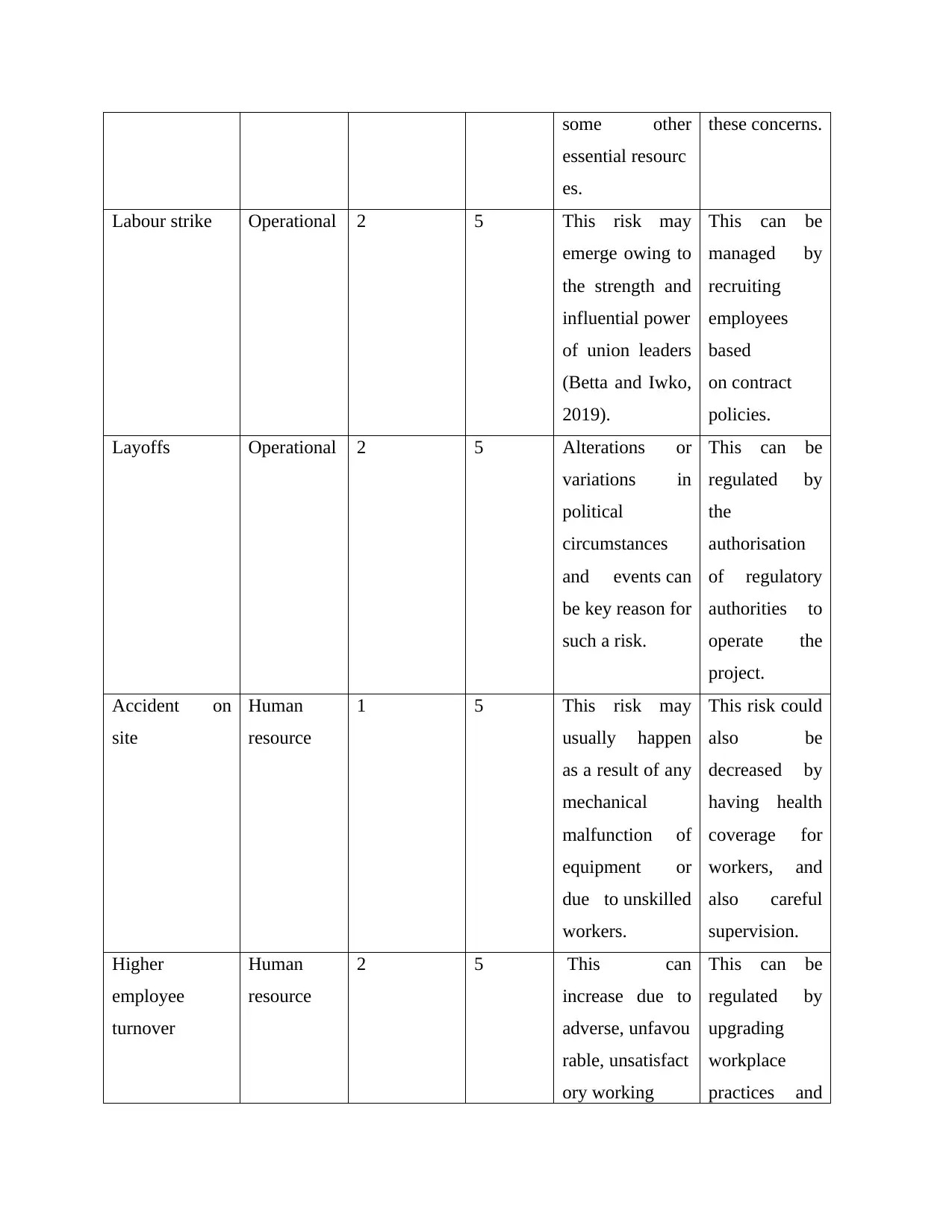
some other
essential resourc
es.
these concerns.
Labour strike Operational 2 5 This risk may
emerge owing to
the strength and
influential power
of union leaders
(Betta and Iwko,
2019).
This can be
managed by
recruiting
employees
based
on contract
policies.
Layoffs Operational 2 5 Alterations or
variations in
political
circumstances
and events can
be key reason for
such a risk.
This can be
regulated by
the
authorisation
of regulatory
authorities to
operate the
project.
Accident on
site
Human
resource
1 5 This risk may
usually happen
as a result of any
mechanical
malfunction of
equipment or
due to unskilled
workers.
This risk could
also be
decreased by
having health
coverage for
workers, and
also careful
supervision.
Higher
employee
turnover
Human
resource
2 5 This can
increase due to
adverse, unfavou
rable, unsatisfact
ory working
This can be
regulated by
upgrading
workplace
practices and
essential resourc
es.
these concerns.
Labour strike Operational 2 5 This risk may
emerge owing to
the strength and
influential power
of union leaders
(Betta and Iwko,
2019).
This can be
managed by
recruiting
employees
based
on contract
policies.
Layoffs Operational 2 5 Alterations or
variations in
political
circumstances
and events can
be key reason for
such a risk.
This can be
regulated by
the
authorisation
of regulatory
authorities to
operate the
project.
Accident on
site
Human
resource
1 5 This risk may
usually happen
as a result of any
mechanical
malfunction of
equipment or
due to unskilled
workers.
This risk could
also be
decreased by
having health
coverage for
workers, and
also careful
supervision.
Higher
employee
turnover
Human
resource
2 5 This can
increase due to
adverse, unfavou
rable, unsatisfact
ory working
This can be
regulated by
upgrading
workplace
practices and
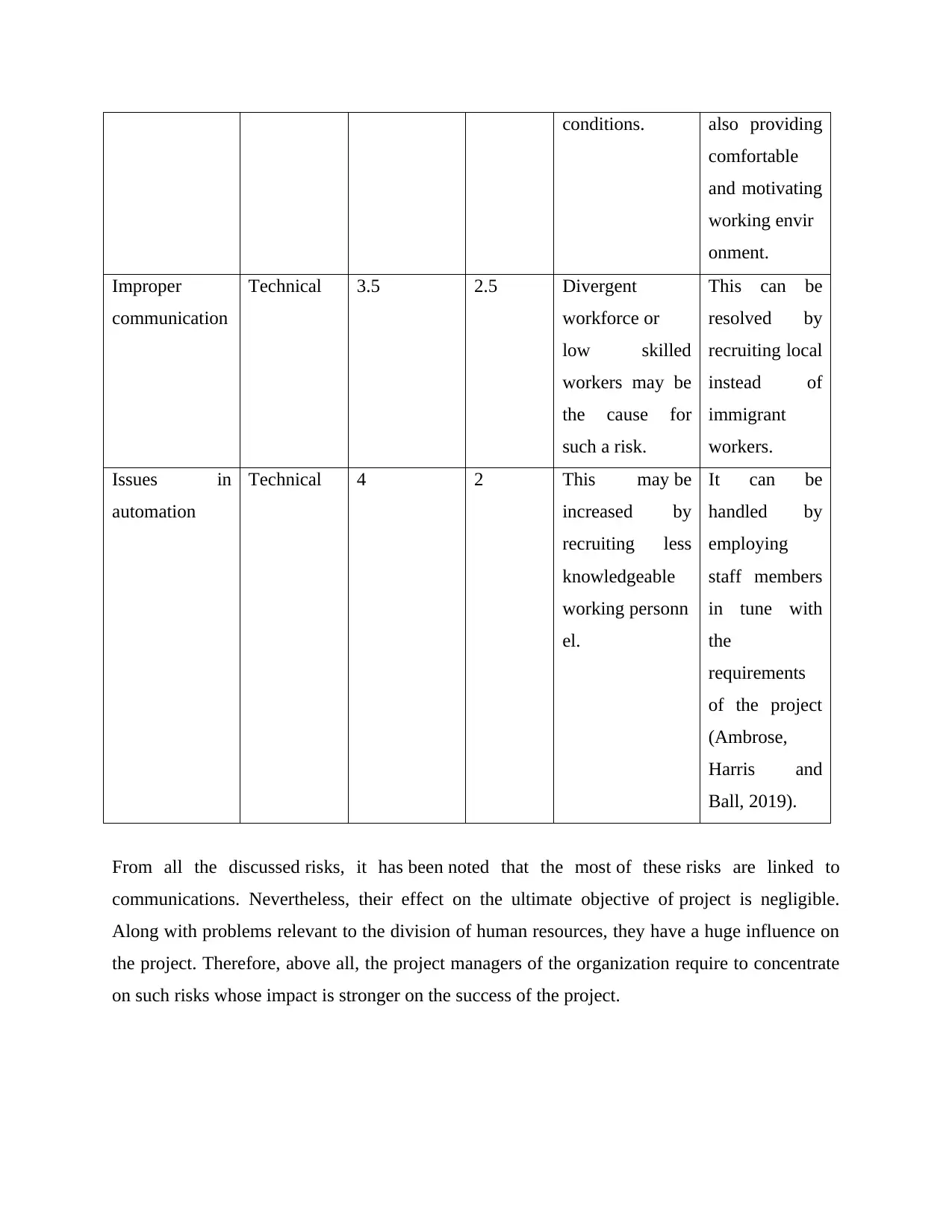
conditions. also providing
comfortable
and motivating
working envir
onment.
Improper
communication
Technical 3.5 2.5 Divergent
workforce or
low skilled
workers may be
the cause for
such a risk.
This can be
resolved by
recruiting local
instead of
immigrant
workers.
Issues in
automation
Technical 4 2 This may be
increased by
recruiting less
knowledgeable
working personn
el.
It can be
handled by
employing
staff members
in tune with
the
requirements
of the project
(Ambrose,
Harris and
Ball, 2019).
From all the discussed risks, it has been noted that the most of these risks are linked to
communications. Nevertheless, their effect on the ultimate objective of project is negligible.
Along with problems relevant to the division of human resources, they have a huge influence on
the project. Therefore, above all, the project managers of the organization require to concentrate
on such risks whose impact is stronger on the success of the project.
comfortable
and motivating
working envir
onment.
Improper
communication
Technical 3.5 2.5 Divergent
workforce or
low skilled
workers may be
the cause for
such a risk.
This can be
resolved by
recruiting local
instead of
immigrant
workers.
Issues in
automation
Technical 4 2 This may be
increased by
recruiting less
knowledgeable
working personn
el.
It can be
handled by
employing
staff members
in tune with
the
requirements
of the project
(Ambrose,
Harris and
Ball, 2019).
From all the discussed risks, it has been noted that the most of these risks are linked to
communications. Nevertheless, their effect on the ultimate objective of project is negligible.
Along with problems relevant to the division of human resources, they have a huge influence on
the project. Therefore, above all, the project managers of the organization require to concentrate
on such risks whose impact is stronger on the success of the project.
⊘ This is a preview!⊘
Do you want full access?
Subscribe today to unlock all pages.

Trusted by 1+ million students worldwide
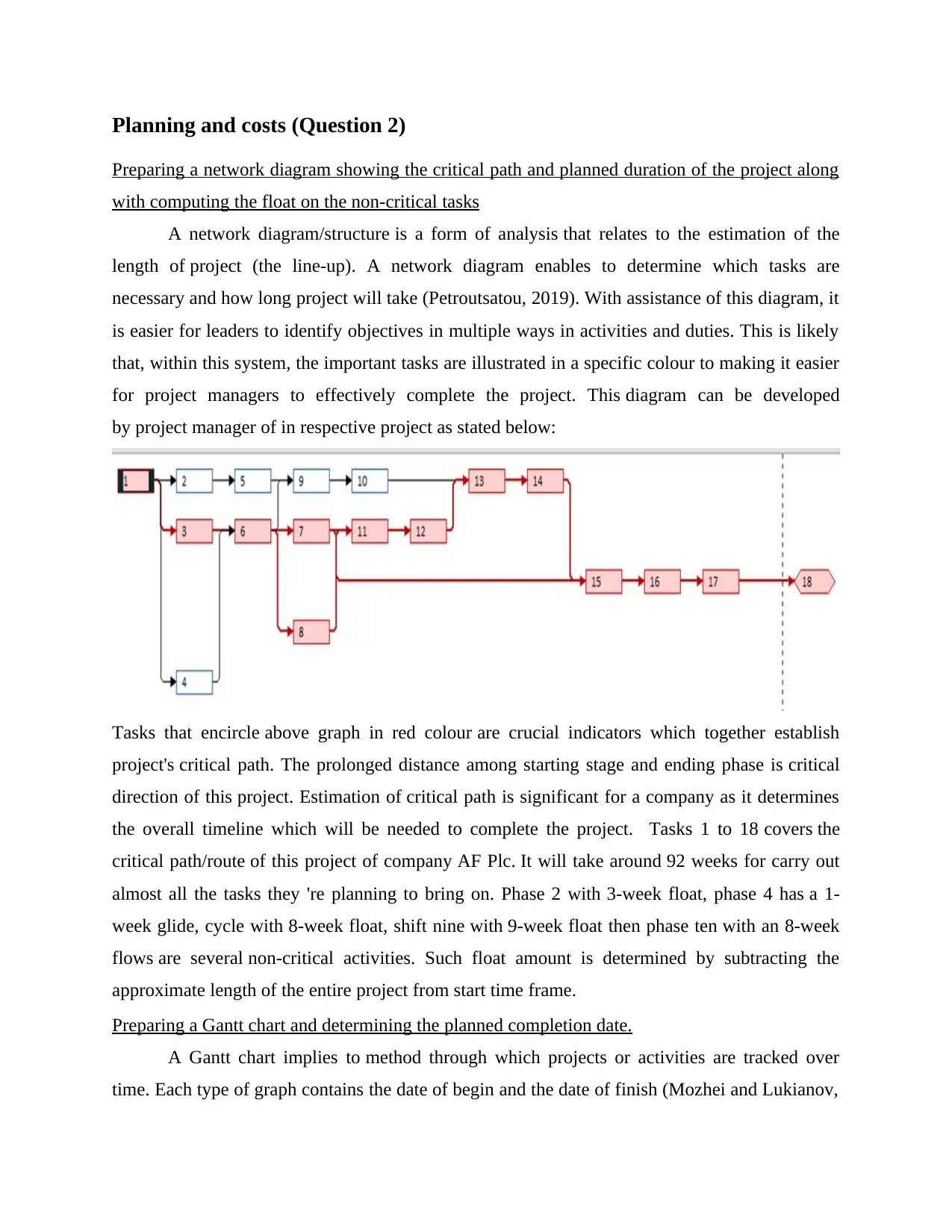
Planning and costs (Question 2)
Preparing a network diagram showing the critical path and planned duration of the project along
with computing the float on the non-critical tasks
A network diagram/structure is a form of analysis that relates to the estimation of the
length of project (the line-up). A network diagram enables to determine which tasks are
necessary and how long project will take (Petroutsatou, 2019). With assistance of this diagram, it
is easier for leaders to identify objectives in multiple ways in activities and duties. This is likely
that, within this system, the important tasks are illustrated in a specific colour to making it easier
for project managers to effectively complete the project. This diagram can be developed
by project manager of in respective project as stated below:
Tasks that encircle above graph in red colour are crucial indicators which together establish
project's critical path. The prolonged distance among starting stage and ending phase is critical
direction of this project. Estimation of critical path is significant for a company as it determines
the overall timeline which will be needed to complete the project. Tasks 1 to 18 covers the
critical path/route of this project of company AF Plc. It will take around 92 weeks for carry out
almost all the tasks they 're planning to bring on. Phase 2 with 3-week float, phase 4 has a 1-
week glide, cycle with 8-week float, shift nine with 9-week float then phase ten with an 8-week
flows are several non-critical activities. Such float amount is determined by subtracting the
approximate length of the entire project from start time frame.
Preparing a Gantt chart and determining the planned completion date.
A Gantt chart implies to method through which projects or activities are tracked over
time. Each type of graph contains the date of begin and the date of finish (Mozhei and Lukianov,
Preparing a network diagram showing the critical path and planned duration of the project along
with computing the float on the non-critical tasks
A network diagram/structure is a form of analysis that relates to the estimation of the
length of project (the line-up). A network diagram enables to determine which tasks are
necessary and how long project will take (Petroutsatou, 2019). With assistance of this diagram, it
is easier for leaders to identify objectives in multiple ways in activities and duties. This is likely
that, within this system, the important tasks are illustrated in a specific colour to making it easier
for project managers to effectively complete the project. This diagram can be developed
by project manager of in respective project as stated below:
Tasks that encircle above graph in red colour are crucial indicators which together establish
project's critical path. The prolonged distance among starting stage and ending phase is critical
direction of this project. Estimation of critical path is significant for a company as it determines
the overall timeline which will be needed to complete the project. Tasks 1 to 18 covers the
critical path/route of this project of company AF Plc. It will take around 92 weeks for carry out
almost all the tasks they 're planning to bring on. Phase 2 with 3-week float, phase 4 has a 1-
week glide, cycle with 8-week float, shift nine with 9-week float then phase ten with an 8-week
flows are several non-critical activities. Such float amount is determined by subtracting the
approximate length of the entire project from start time frame.
Preparing a Gantt chart and determining the planned completion date.
A Gantt chart implies to method through which projects or activities are tracked over
time. Each type of graph contains the date of begin and the date of finish (Mozhei and Lukianov,
Paraphrase This Document
Need a fresh take? Get an instant paraphrase of this document with our AI Paraphraser
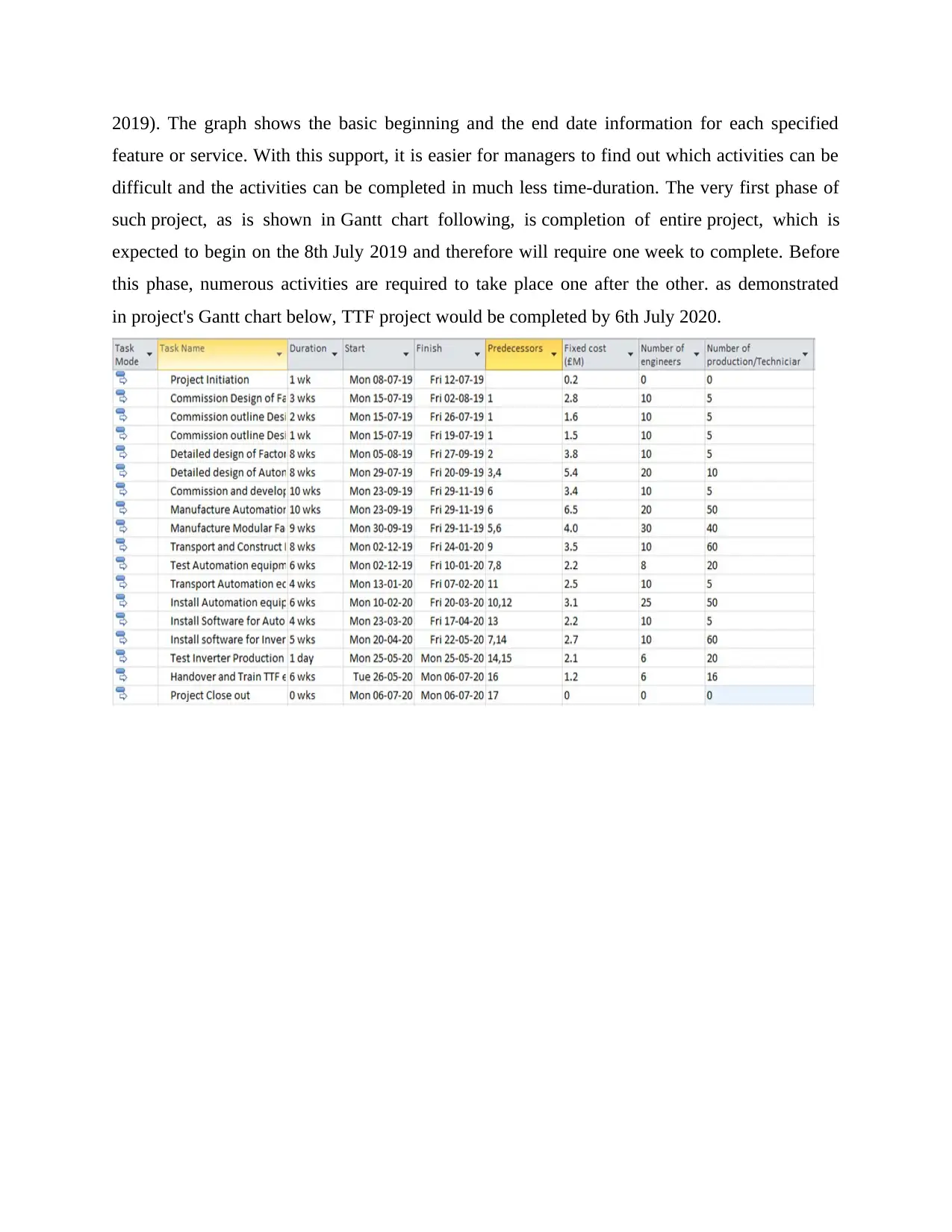
2019). The graph shows the basic beginning and the end date information for each specified
feature or service. With this support, it is easier for managers to find out which activities can be
difficult and the activities can be completed in much less time-duration. The very first phase of
such project, as is shown in Gantt chart following, is completion of entire project, which is
expected to begin on the 8th July 2019 and therefore will require one week to complete. Before
this phase, numerous activities are required to take place one after the other. as demonstrated
in project's Gantt chart below, TTF project would be completed by 6th July 2020.
feature or service. With this support, it is easier for managers to find out which activities can be
difficult and the activities can be completed in much less time-duration. The very first phase of
such project, as is shown in Gantt chart following, is completion of entire project, which is
expected to begin on the 8th July 2019 and therefore will require one week to complete. Before
this phase, numerous activities are required to take place one after the other. as demonstrated
in project's Gantt chart below, TTF project would be completed by 6th July 2020.

⊘ This is a preview!⊘
Do you want full access?
Subscribe today to unlock all pages.

Trusted by 1+ million students worldwide
1 out of 25